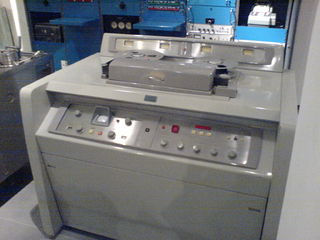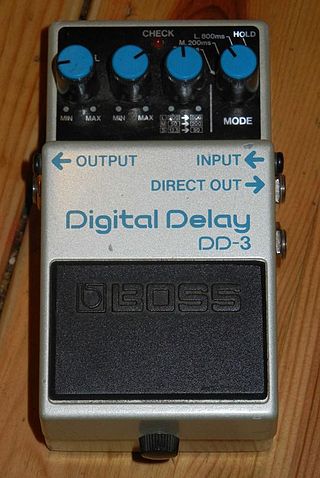
The VHS is a standard for consumer-level analog video recording on tape cassettes, invented in 1976 by the Victor Company of Japan (JVC). It was the dominant home video format throughout the tape media period in the 1980s and 1990s.

The Compact Cassette, also commonly called a cassette tape, audio cassette, or simply tape or cassette, is an analog magnetic tape recording format for audio recording and playback. Invented by Lou Ottens and his team at the Dutch company Philips and released in August 1963, Compact Cassettes come in two forms, either containing content as a prerecorded cassette (Musicassette), or as a fully recordable "blank" cassette. Both forms have two sides and are reversible by the user. Although other tape cassette formats have also existed—for example the Microcassette—the generic term cassette tape is normally used to refer to the Compact Cassette because of its ubiquity.

Digital Audio Tape is a signal recording and playback medium developed by Sony and introduced in 1987. In appearance it is similar to a Compact Cassette, using 3.81 mm / 0.15" magnetic tape enclosed in a protective shell, but is roughly half the size at 73 mm × 54 mm × 10.5 mm. The recording is digital rather than analog. DAT can record at sampling rates equal to, as well as higher and lower than a CD at 16 bits quantization. If a comparable digital source is copied without returning to the analogue domain, then the DAT will produce an exact clone, unlike other digital media such as Digital Compact Cassette or non-Hi-MD MiniDisc, both of which use a lossy data-reduction system.

An audio tape recorder, also known as a tape deck, tape player or tape machine or simply a tape recorder, is a sound recording and reproduction device that records and plays back sounds usually using magnetic tape for storage. In its present-day form, it records a fluctuating signal by moving the tape across a tape head that polarizes the magnetic domains in the tape in proportion to the audio signal. Tape-recording devices include the reel-to-reel tape deck and the cassette deck, which uses a cassette for storage.
A cassette deck is a type of tape machine for playing and recording audio cassettes that does not have a built-in power amplifier or speakers, and serves primarily as a transport. It can be a part of an automotive entertainment system, a part of a portable mini system or a part of a home component system. In the latter case it is also called a component cassette deck or just a component deck.

Ampex Data Systems Corporation is an American electronics company founded in 1944 by Alexander M. Poniatoff as a spin-off of Dalmo-Victor. The name AMPEX is a portmanteau, created by its founder, which stands for Alexander M. Poniatoff Excellence. Ampex operates as Ampex Data Systems Corporation, a subsidiary of Delta Information Systems, and consists of two business units. The Silicon Valley unit, known internally as Ampex Data Systems (ADS), manufactures digital data storage systems capable of functioning in harsh environments. The Colorado Springs, Colorado, unit, referred to as Ampex Intelligent Systems (AIS), serves as a laboratory and hub for the company's line of industrial control systems, cyber security products and services and its artificial intelligence/machine learning technology.

Mastering, a form of audio post production, is the process of preparing and transferring recorded audio from a source containing the final mix to a data storage device, the source from which all copies will be produced. In recent years, digital masters have become usual, although analog masters—such as audio tapes—are still being used by the manufacturing industry, particularly by a few engineers who specialize in analog mastering.

Multitrack recording (MTR), also known as multitracking, is a method of sound recording developed in 1955 that allows for the separate recording of multiple sound sources or of sound sources recorded at different times to create a cohesive whole. Multitracking became possible in the mid-1950s when the idea of simultaneously recording different audio channels to separate discrete tracks on the same reel-to-reel tape was developed. A track was simply a different channel recorded to its own discrete area on the tape whereby their relative sequence of recorded events would be preserved, and playback would be simultaneous or synchronized.

The Digital Compact Cassette (DCC) is a magnetic tape sound recording format introduced by Philips and Matsushita Electric in late 1992 and marketed as the successor to the standard analog Compact Cassette. It was also a direct competitor to Sony's MiniDisc (MD), but neither format toppled the then-ubiquitous analog cassette despite their technical superiority, and DCC was discontinued in October 1996.

Reel-to-reel audio tape recording, also called open-reel recording, is magnetic tape audio recording in which the recording tape is spooled between reels. To prepare for use, the supply reel containing the tape is placed on a spindle or hub. The end of the tape is manually pulled from the reel, threaded through mechanical guides and over a tape head assembly, and attached by friction to the hub of the second, initially empty takeup reel. Reel-to-reel systems use tape that is 1⁄4, 1⁄2, 1, or 2 inches wide, which normally moves at 3+3⁄4, 7+1⁄2, 15 or 30 inches per second. Domestic consumer machines almost always used 1⁄4 inch (6.35 mm) or narrower tape and many offered slower speeds such as 1+7⁄8 inches per second (4.762 cm/s). All standard tape speeds are derived as a binary submultiple of 30 inches per second.
Betacam is a family of half-inch professional videocassette products developed by Sony in 1982. In colloquial use, Betacam singly is often used to refer to a Betacam camcorder, a Betacam tape, a Betacam video recorder or the format itself.

A video tape recorder (VTR) is a tape recorder designed to record and playback video and audio material from magnetic tape. The early VTRs were open-reel devices that record on individual reels of 2-inch-wide (5.08 cm) tape. They were used in television studios, serving as a replacement for motion picture film stock and making recording for television applications cheaper and quicker. Beginning in 1963, videotape machines made instant replay during televised sporting events possible. Improved formats, in which the tape was contained inside a videocassette, were introduced around 1969; the machines which play them are called videocassette recorders.

A digital audio workstation is an electronic device or application software used for recording, editing and producing audio files. DAWs come in a wide variety of configurations from a single software program on a laptop, to an integrated stand-alone unit, all the way to a highly complex configuration of numerous components controlled by a central computer. Regardless of configuration, modern DAWs have a central interface that allows the user to alter and mix multiple recordings and tracks into a final produced piece.

The 8mm video format refers informally to three related videocassette formats. These are the original Video8 format and its improved successor Hi8, as well as a more recent digital recording format known as Digital8. Their user base consisted mainly of amateur camcorder users, although they also saw important use in the professional television production field.
TASCAM is the professional audio division of TEAC Corporation, headquartered in Santa Fe Springs, California. TASCAM established the Home Recording phenomenon by creating the "Project Studio" and is credited as the inventor of the Portastudio, the first cassette-based multi-track home studio recorders. TASCAM also introduced the first low-cost mass-produced multitrack recorders with Simul-Sync designed for recording musicians, and manufactured reel-to-reel tape machines and audio mixers for home recordists from the early 1970s through the mid-1990s. Since the early 00's, TASCAM has been an early innovator in the field-recording and audio accompaniment to video with their DR-series recording platforms. TASCAM celebrated its 50th anniversary in 2021.

The TASCAM Portastudio was the first four-track recorder based on a standard compact audio cassette tape. The term portastudio is exclusive to TASCAM, though it is generally used to describe all self-contained cassette-based multitrack recorders dedicated to music production. The Portastudio, and particularly its first iteration, the Teac 144, is credited with launching the home-recording wave, which allowed musicians to cheaply record and produce music at home, and is cited as one of the most significant innovations in music production technology.
A transport is a device that handles a particular physical storage medium itself, and extracts or records the information to and from the medium, to an outboard set of processing electronics that the transport is connected to.

Delay is an audio signal processing technique that records an input signal to a storage medium and then plays it back after a period of time. When the delayed playback is mixed with the live audio, it creates an echo-like effect, whereby the original audio is heard followed by the delayed audio. The delayed signal may be played back multiple times, or fed back into the recording, to create the sound of a repeating, decaying echo.
Foster Denki KK is an electronics company that manufactures loudspeakers and audio equipment for other companies or sells them under the trade name Fostex. It is traded on the Tokyo Stock Exchange.

Multitrack recording of sound is the process in which sound and other electro-acoustic signals are captured on a recording medium such as magnetic tape, which is divided into two or more audio tracks that run parallel with each other. Because they are carried on the same medium, the tracks stay in perfect synchronization, while allowing multiple sound sources to be recorded at different times.















